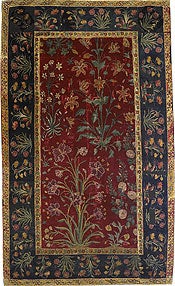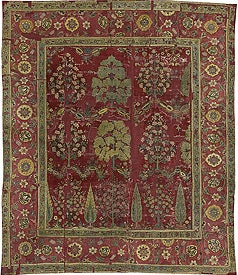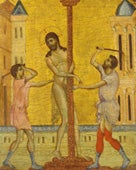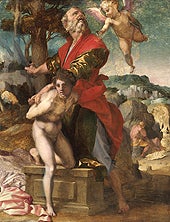Goya’s Last Works
February 22 through May 14, 2006
Use the following links to view the Goya's Last Works exhibition online and for the Virtual Tour of the exhibition (Quicktime required).
Goya’s understated portrait of the woman known as María Martínez de Puga, acquired by Henry Clay Frick in 1914, was the inspiration for The Frick Collection’s special exhibition Goya’s Last Works. It was the first show in the United States to concentrate exclusively on the final phase of Goya’s long career — the years of the artist’s voluntary exile in Bordeaux from 1824 to 1828. Fifty-one examples of Goya’s final production were borrowed from public and private European and North American collections. This ensemble of drawings, paintings, miniatures on ivory, and lithographs demonstrated the vitality and irrepressible creativity of an artist who, at age seventy-eight, pulled up roots in Madrid, his home for the preceding half century, and started over in France.
Goya’s departure from Spain was prompted by Ferdinand VII’s restoration to the throne in 1823 and the brutal repression of Liberals that followed. Settling in the vibrant port city of Bordeaux, Goya found companionship among friends old and new in a large community of Spanish exiles. There he created a brilliant coda to the significant body of work he had produced in Spain for both royal patrons and proponents of the Enlightenment. Included in the exhibition were eight portraits on canvas dating from 1820 to 1827, which reveal the technical freedom, daring simplicity, and penetrating insight into character that typify his final works in this genre. They were complemented by a group of extraordinary miniature paintings on tiny plaques of ivory, executed in a technique of Goya’s own invention. A selection of lithographs, including the series of four prints known as the Bulls of Bordeaux — considered the first masterpieces of the new medium — demonstrated his restless will to experiment and expand the boundaries of his art, despite advanced age and poor health. Drawings from Goya’s two Bordeaux albums allowed the viewer to follow his unedited thoughts — his reminiscences of Spain; witty observations of Bordeaux’s street life; preoccupation with longstanding themes of human folly, madness, and witchcraft; and indulgence in pure fantasy—and attest to his unflagging imagination and powerful will to sustain his life through art.
Goya’s Last Works was organized by Jonathan Brown, Carroll and Milton Petrie Professor of the Institute of Fine Arts, New York University, and Frick Curator Susan Grace Galassi. Goya’s Last Works was accompanied by a full-color catalogue published by Yale University Press, which is available in the Museum Shop.
Principal funding for Goya's Last Works has been provided by the Robert Lehman Foundation, with major support from Merrill Lynch; Melvin R. Seiden in honor of Jonathan Brown and Susan Grace Galassi; The Widgeon Point Charitable Foundation; Mr. and Mrs. Walter A. Eberstadt; The Samuel H. Kress Foundation; and The Getty Grant Program of The J. Paul Getty Trust. The catalogue has been generously underwritten by Lawrence and Julie Salander and made possible, in part, by Furthermore: A Program of the J. M. Kaplan Fund. Support for scholarly programming has been provided by the Arthur Ross Foundation. Additional support has been provided by The Helen Clay Frick Foundation and the Fellows of The Frick Collection.
This exhibition is also supported by an indemnity from the Federal Council on the Arts and Humanities.
Veronese’s Allegories:
Virtue, Love, and Exploration in Renaissance Venice
April 11 through July 16, 2006
 |
|
|
| Paolo Veronese, The Choice Between Virtue and Vice, c. 1565, The Frick Collection, New York |
|
The art of Paolo Veronese (1528–1588) is inextricably linked to the idea of opulence and splendor in Renaissance Venice. His paintings are grandiose visions of the richness and spectacle of sixteenth-century Venetian life. Crowded compositions with theatrical effects, in which groups of sumptuously dressed people re-enact religious and secular events, have become synonymous with Veronese’s oeuvre, and his dazzling and effective use of color has been praised and celebrated over the centuries.
This exhibition brought together for the first time five of Veronese’s magnificent compositions and reunited all of the painter’s large-scale allegorical works from museums in the United States. By displaying this group of paintings together, the exhibition allowed issues such as their dating, original commission, and meaning to be examined under fresh light. Veronese’s technique and the means he used to achieve specific effects of composition, color, and texture in his works were also an important component of the exhibition.
By exploring the history and meaning of Veronese’s five Allegories, we hope to have reached an understanding of the ways in which the artist conveyed varying messages and ideas through allegorical devices. It also became apparent that these paintings were an important part of Veronese’s self-fashioning as a Venetian artist and were aimed at a local and international audience.
The exhibition would have not been possible without the generous help of The Christian Humann Foundation., to whom we are greatly indebted. Additional invaluable support has been provided by The Gladys Krieble Delmas Foundation, Hester Diamond, The Helen Clay Frick Foundation, and the Fellows of The Frick Collection. This publication is made possible thanks to the generosity of Lawrence and Julie Salander.
Jean-Étienne Liotard (1702-1789): Swiss Master
June 13 through September 17, 2006
| |
 |
|
|
| |
Jean-Étienne Liotard (1702-1789), Liotard Laughing, c. 1770, oil on canvas, 84 x 74 (33 1/16 x 29 1/8), Musée d’art et d’histoire, Département des Beaux-Arts |
|
|
The Frick continued to add to its holdings, and the 1997 gift of a painting inspired a major 2006 exhibition on the artist Jean-Étienne Liotard (1702-1789). This presentation offerd the public a singular opportunity to become better acquainted with one of the most original and engaging artists of eighteenth-century Europe, who enjoyed an international reputation in his day, often painting portraits of monarchs and their children in London, Vienna, Parma, and Amsterdam. Indeed, the Frick served as the only venue for this monographic survey of an artist who is little known even among specialists today and is rarely seen outside of collections in Geneva. Accompanied by a general introductory publication — the first in English — to the encyclopedic holdings of Liotard’s work in Geneva, the exhibition comprised paintings, drawings, and engravings from the Musée d’art et d’histoire, as well as a selection of his pastels from private collections.
Liotard skillfully worked in a broad range of media, including oil, enamel, pastel, and engraving, as well as in gouache, chalk, and watercolor for his drawings. Trained as a portraitist, a miniaturist, and an engraver, Liotard was direct in his treatment of sitters, himself included. His keen attention to the physiognomic detail of his sitters and his careful rendering of them produced close likenesses that exemplified his realistic approach to painting. Audiences were be delighted and instructed by the artist’s depictions of himself as well as his family, patrons, and contemporaries in a style that could truly be called a “mirror of nature.”
| Presentation of the exhibition was made possible, in part, through the generous support of Margot and Jerry Bogert; Melvin R. Seiden in honor of Jean A. Bonna and Inez and Yves Oltramare, with additional support from Inez and Yves Oltramare; Jean A. Bonna; Pro Helvetia, Arts Council of Switzerland; The Helen Clay Frick Foundation; and the Fellows of The Frick Collection. Transportation costs have been generously underwritten by Swiss International Air Lines. The catalogue was made possible, in part, by Lawrence and Julie Salander. |
 |
Gardens of Eternal Spring: Two Mughal Carpets in The Frick Collection
July 25 through October 1, 2006
The two magnificent carpets on display in the Oval Room beginning July 25 were among the fewer than five hundred that survive from the court of the Mughal emperors. Woven in northern India in the mid-seventeenth century, these carpets were luxurious objects in terms of both the fabrics used to make them (silk and cashmere) and the artistically complex patterns that they display. The Frick carpets date from the reign of Shah Jahan (1628–1658) and were probably made at the royal factory in Lahore, one of India’s main cities for carpet production.
 |
|
 |
|
| Northern Indian, reign of Shah Jahan (1628-1658), Carpet with Floral Pattern, first half of 17th century, silk and pashmina, 76 in. x 46 in. (193.04 cm x 116.84 cm), Henry Clay Frick Bequest, 1916.10.08 |
|
Northern Indian, reign of Shah Jahan (1628-1658), Carpet with Tree Pattern, first half of 17th century, silk and pashmina, 89 5/16 in. x 75 5/8 in. (226.82 cm x 192.02 cm), Henry Clay Frick Bequest, 1916.10.07, Both carpets photographed by Michael Bodycomb, The Frick Collection |
In constant use in palaces and mosques, carpets seldom survive in pristine condition over the centuries. The Frick rugs were each assembled from fragments of much larger carpets at some point during the nineteenth century, a common practice at the time owing to the demand by collectors.
The larger of the two, which is decorated with rows of trees, was most likely assembled from the carpet that was sent as a gift to the tomb mosque of Sheikh Safi in Ardabil in Persia by Shah Jahan himself. Its decoration, like that of the smaller carpet — which displays a variety of flowers — is meant to represent a garden in a mode directly connected with Mughal miniatures and relief decoration. Their rich crimson color is typically associated with Indian carpets from this period and provides a vibrant and sumptuous background against which the plants are set.
Henry Clay Frick purchased the two carpets in 1918 as furnishings for his New York home at 1 East Seventieth Street. After a nearly four-year restoration by pre-eminent textile conservator Nobuko Kajitani, they were displayed as works of art in their own right.
The conservation and presentation of Gardens of Eternal Spring: Two Newly Conserved Mughal Carpets was generously supported by The Hagop Kevorkian Fund, The Ahmanson Foundation, The Helen Clay Frick Foundation, and the Fellows of The Frick Collection.
Cimabue and Early Italian Devotional Painting
October 3 through December 31, 2006
|
 |
|
 |
|
|
|
|
| |
Cimabue (Cenni di Peppo) (c. 1240-c. 1302), The Virgin and Child Enthroned with Two Angels, c. 1280, tempera on panel, The National Gallery, London |
|
Cimabue (Cenni di Peppo) (c. 1240-c. 1302), The Flagellation of Christ,
c. 1280, tempera on panel, The Frick Collection,
New York |
|
|
|
|
Six years ago, The Frick Collection’s Flagellation of Christ was confirmed to be by the artist Cenni di Pepo (c. 1240–c. 1302), known as Cimabue, following the discovery of The Virgin and Child Enthroned with Two Angels (now in the National Gallery, London), a panel known to have been painted by the Florentine master. Beginning October 3, visitors to the Frick had the rare opportunity to see these two panels side by side — the first time they have been together in America — when The Virgin and Child traveled to New York for this special exhibition. A selection of panels, manuscripts, and verre églomisé (painted and gilded glass) were also on view, illustrating the various forms of small-scale devotional art with which Cimabue and his contemporaries experimented.
The Frick Collection purchased The Flagellation of Christ in 1950, and it remains the only painting by Cimabue in the United States. At first glance, the Flagellation and the Virgin and Child appear different owing to the presence of a modern-day varnish on the National Gallery panel. Their carpentry, condition, style, and technique, however, attest to their origins as part of the same work, either a small altarpiece, diptych, or triptych. The grain of the wood, the thickness of the panels (both of which have been thinned down since they were first painted), the pattern of craquelure in the paint, and even the worm holes in the wood are comparable. Both feature a similar punched border in the gold ground, consisting of two rows of pinprick-like punches surrounding a delicate scroll pattern formed by tiny punch marks. Such parallels between the two panels confirm that both were once part of the same ensemble. At an unknown date, the larger work was cut apart, probably so that smaller pieces of it could be sold individually, a fate that befell many early Italian pictures during the late eighteenth and early nineteenth century.
Without question, the Frick and National Gallery panels rank among the finest known works of thirteenth-century painting. Although vastly different in emotional tenor, both emphasize Christ’s humanity, a theme particularly important to members of the Franciscan order, the most powerful religious group in Italy during the thirteenth century and likely the group that commissioned the work. The engaging expressions of Christ, the Virgin, and the angels combined with the delicacy of both paintings’ execution attest to Cimabue’s ability to create powerful, timeless images truly revolutionary in their day.
For more information, see the online exhibition.
Cimabue and Early Italian Devotional Painting was coordinated for The Frick Collection by former Andrew W. Mellon Curatorial Fellow Holly Flora (now Curator, Museum of Biblical Art, New York) in conjunction with the Frick’s Associate Curator Denise Allen.
The exhibition has been generously underwritten by Jon and Barbara Landau. Additional support has been provided by The Council of The Frick Collection and The Helen Clay Frick Foundation. The accompanying publication was made possible, in part, by Lawrence and Julie Salander.
Domenico Tiepolo (1727–1804): A New Testament
October 24, 2006, through January 7, 2007
| |
 |
|
|
| |
Domenico Tiepolo (1727–1804), Jesus in the Garden of Gethsemane:The Second Prayer, Pen and wash, Private Indiana Collection on loan to the Indiana University Art Museum |
|
|
The eighteenth-century Venetian painter and draftsman Domenico Tiepolo is best known for his drawn narrative cycles of the commedia dell’ arte character Punchinello and engaging scenes of everyday life in the Veneto. He reserved his greatest passion, however, for sacred subjects. This exhibition, organized by guest curator Adelheid Gealt, director of the Indiana University Art Museum, presented sixty key examples from Domenico’s New Testament cycle, his most extensive and least-known cycle of more than three hundred large finished drawings illustrating the events of early Christianity through the foundation of the Church. Shortly after the artist’s death in 1804, the drawings, which were executed roughly between 1786 and 1790, were divided into two groups. The first group stayed together in an album (now in the Musée du Louvre), while the sheets from the second group were widely dispersed. The works were not recorded in Domenico’s lifetime, nor did the artist leave any clues as to their order, or even provide titles for them. So far, no patron for this vast undertaking has been discovered, nor has any motive other than the artist’s personal interest and deep piety emerged. The Frick exhibition was the first to present these works to the public.
This exhibition coincided with the landmark publication by Dr. Gealt and George Knox, professor emeritus, University of British Columbia, of the catalogue raisonné of Domenico’s New Testament cycle — a monumental feat of art historical and biblical scholarship that brings together for the first time all 313 known drawings. Over the course of a decade, Gealt and Knox tracked down far-flung sheets, traced the scenes to their textual and visual sources, and assigned each drawing a place in the series, which is the largest-known sacred cycle created by a single artist. Together, the exhibition and publication restore Domenico’s lost masterpiece to its original context.
Domenico made use of a wide variety of compositional devices, gestures, and settings for his New Testament cycle, mining existing art — from early Christian to the art of his contemporaries — for inspiration. The cycle as a whole bears the strong imprint of the artist’s time and locale through references to familiar Venetian monuments and everyday life, as well as motifs from works by Titian, Veronese, and his father, Giambattista Tiepolo (1696–1770), whose virtuosic frescoes adorned the ceilings of many of the great villas and churches of eighteenth-century Europe.
While a number of works included in the exhibition displayed Domenico’s gifts as a storyteller and chronicler of his time, others revealed the depth of his piety and empathy. He approached his project as an interpreter and biblical scholar, drawing his own conclusions about the events from all the available, often conflicting, literary sources known to him, in order to infuse his cycle with a more complete and complex rendering of the Christian epic.
This exhibition was organized by guest curator Adelheid Gealt and coordinated for The Frick Collection by Susan Grace Galassi.
Principal funding for Domenico Tiepolo (1727–1804): A New Testament was provided by The Peter Jay Sharp Foundation, with major support from the Homeland Foundation. Additional generous support was provided by Lawrence and Julie Salander, the Samuel H. Kress Foundation, the Arthur Ross Foundation, The Helen Clay Frick Foundation, and the Fellows of The Frick Collection.
 |
|
The project was also supported, in part, by an award from the National Endowment for the Arts, which believes that a great nation deserves great art. |
Masterpieces of European Painting from The Cleveland Museum of Art
November 8, 2006, through January 28, 2007
| |
 |
|
|
| |
Andrea d’Agnolo del Sarto (1486–1530), The Sacrifice of Isaac, c. 1527, oil on poplar, The Cleveland Museum of Art, Cleveland, Ohio, Delia E. Holden and l. W. Holden Funds |
|
|
For many years, The Frick Collection has offered its visitors the chance to view important Old Master paintings from American institutions outside the New York area. In keeping with this tradition, the Frick presented fourteen extraordinary works from the renowned Cleveland Museum of Art. Ranging in date from the early Renaissance to the mid-nineteenth century, the selection included canvases by artists represented in the Frick’s permanent collection alongside paintings by important masters not typically seen at the museum. This exciting opportunity was the result of the temporary closing of The Cleveland Museum, which was undergoing a major renovation and expansion of its site.
Like The Frick Collection, The Cleveland Museum of Art was established with funds bequeathed by wealthy individuals whose fortunes were made during the industrial boom of the Gilded Age. It opened to the public in 1916. Today, the institution is widely recognized as one of the premier encyclopedic art museums in North America. Besides paintings, its diverse permanent collection includes drawings, prints, photography, sculpture, and decorative arts from a wide array of geographic locations, spanning some six thousand years. Masterpieces of European Painting from The Cleveland Museum of Art will feature paintings selected to harmonize with the temporal and aesthetic boundaries established by the Frick’s founder, Henry Clay Frick. The show included works by Fra Filippo Lippi (1406–1469), Andrea del Sarto (1486–1530), El Greco (1541–1614), Annibale Carracci (c. 1560–1609), Michelangelo Merisi da Caravaggio (1573–1610), Frans Hals (c. 1581–1666), Georges de La Tour (1593–1652), Valentin de Boulogne (1594–1632), Nicolas Poussin (1594–1665), Francisco de Zurbarán (1598–1664), Diego de Velázquez (1599–1660), Jacques-Louis David (1748–1825), and J. M. W. Turner (1775–1851).
Masterpieces of European Painting from The Cleveland Museum of Art was organized by Colin B. Bailey, Chief Curator of The Frick Collection, with the assistance of Margaret Iacono, Assistant Curator, in collaboration with The Cleveland Museum of Art. A fully illustrated catalogue, including an essay by Margaret Iacono comparing the collecting histories of the Frick and Cleveland museums, is available in the Museum Shop.
The exhibition was made possible, in part, by the generous support of Melvin R. Seiden in honor of Sherman Lee and by Mr. and Mrs. Walter A. Eberstadt in honor of Michael J. Horvitz. The accompanying catalogue was made possible, in part, by Lawrence and Julie Salander. |


